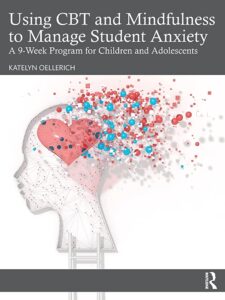Help Kids Take Charge of Their Emotions
By Katelyn Oellerich, Ed.S.

At the age of six, when asked to talk through a tough situation that had happened, he wiggled his body around and said It “feels yucky on the inside to talk about.” This expression and his body movements conveyed his want to avoid the emotion.
What my son shared – his general awareness and acceptance of these emotions, thoughts, and feelings that were arising within his body – is something that is challenging for most of us. Cultivating a mindful stance helps us to recognize what is happening within us (Bishop, et al., 2004), while cognitive behavioral therapy offers strategies to reframe maladaptive thoughts and behaviors (Beck & Beck, 2011).
Children can learn to take charge of these emotions by recognizing when they arise and using strategies to reframe their thinking and options. Two strategies from my book Using CBT and Mindfulness to Manage Student Anxiety that can be especially helpful in this process are:
- Most Likely Scenario
- Possible Options
Most Likely Scenario
The most likely scenario can be used when a student is struggling with thoughts that may seem unrealistic and focused on the worst case happening (although the worst case is unlikely to occur). The components of this strategy include:
Understand the situation, and then support the student in considering:
● What is the worst thing that could happen?
● What evidence goes against this worst case happening?
● What is the best thing that could happen?
● What is most likely to happen?
This strategy might be used when talking with a student about their fear of giving a presentation.
Adult: Tell me what’s on your mind?
Student: Well, I need to give a presentation later today and I’m really nervous.
Adult: Oh yes, presentations can be a bit intimidating. Tell me, when you worry about this, what is the worst thing you think might happen?
Student: Everyone would laugh and make fun of me for stumbling on my words.
Adult: Alright, now think about how likely that is to actually happen… what evidence do you have that goes against everyone laughing? What are you aware of that might make that unlikely to occur?
Student: Well, I know the teacher would be upset if everyone laughed, and I have a few friends in the class and I don’t think they would laugh at me. I also feel pretty prepared for what I am supposed to say.
Adult: Ok, so it sounds like you’ve done a lot of preparation and have other factors in the class that make this situation unlikely to happen. What is the best thing that may happen when you give your presentation?
Student: Well, getting an A would be pretty great.
Adult: Ok, that’s a nice goal. What do you think is most likely to happen when you give your presentation?
Student: I’d guess I will be kind of nervous, but I’ll likely do fine and probably get a decent grade.
Talking a student through a situation in this way supports them in recognizing their thoughts and realizing that they have the power to reframe their thinking and can calm their worry by bringing their fear back into reality.
Possible Options
In addition to reframing thoughts, teaching students how to consider different possibilities to a problem can also be helpful in supporting their resiliency.
Components of this strategy include:
● Explaining the situation of worry
● Considering possible options
● Choosing the option that would be best
Within each possible option we want to:
● Identify the possible outcome
● Rank the level of anxiety (1-5) related to carrying out that option
● Express the ability to manage the anxiety from that option
Exploring possible options can be used to determine a solution to a problem and to call upon the student’s capacity to use pre-taught coping strategies to work through any anxiety that may arise from potential options. The following shows an example of a conflict with a friend.
Adult: Tell me what’s on your mind?
Student: My friend Sonya didn’t say hi to me in the hallway. I’m worried she’s mad at me, but I don’t know what I did to her.
Adult: I know you and Sonya are close. This must really be weighing on you. Let’s think about how you could solve this problem.
____________________
Option 1:
Student: Well, I could ask Sonya what’s wrong and if she’s mad at me.
Adult: Yes, and what might she say?
Student: I’m not sure. Maybe that she didn’t see me? Or she might say she was mad about something I did.
Adult: How anxious might that make you feel on a rating of 1-5 with 5 being incredibly anxious and 1 being not worried at all.
Student: Probably a 2. I know Sonya pretty well, but I’m nervous about what she might say.
Adult: How do you feel about your capacity to manage this worry?
Student: I would probably be able to handle talking to Sonya. I’d start by taking a deep breath.
Option 2:
Adult: What’s another option?
Student: I could decide not to talk to Sonya.
Adult: You could, and what would be the outcome of that option?
Student: I’d really miss Sonya, and she might get more upset if I am not talking to her.
Adult: How anxious would that make you feel?
Student: I’d say a 4. I would be worried about what she might be mad about and miss talking to her. I’d be able to support this worry by talking to someone about my stress and doing something I enjoy like drawing.
Adult: How do you feel about your capacity to manage this amount of worry?
Student: That would be tough for me to not know and not talk to Sonya. I’m not sure I could manage this worry.
Option 3:
Adult: Can you think of any other options?
Student: Well, I could ask someone else if they know if Sonya is mad at me?
Adult: Sure. What might be the outcome of this option?
Student: They may not know anything about the look Sonya gave me, and I’d continue to be confused. Or, maybe they know and don’t want to tell me. Or, they could know and then help me in understanding what’s going on.
Adult: How anxious does this option make you feel?
Student: Probably a 1. I wouldn’t feel very nervous about doing this, but I’m not sure I’ll get the answer I’m hoping for.
______________________
Adult: Ok, thinking about these three options, what do you see as the most beneficial choice?
Student: I’d have to say talking right to Sonya. I may feel a little nervous about it, but I won’t know what’s really going on unless I talk directly to her.
By talking about not only potential options but also how the options may impact anxiety, a student can really consider what option feels most appropriate for their situation.
Summary
When struggling with anxiety, our students need support in developing strategies to help break down the problem. Chunking the problem and probing into options can help make a problem feel more manageable, while reframing maladaptive thoughts helps to build helpful thinking and diminish negative thinking. Our students don’t have to remain stuck, and with our help they can gain lifelong problem solving skills.
Read a MiddleWeb review of Katelyn Oellerich’s Using CBT and Mindfulness to Manage Student Anxiety here.

Katelyn has presented research focused on Mindfulness and Planning and Organization Skills and has additional training in social-emotional learning, art therapy, trauma sensitive schools, Families and Schools Together, and gender inclusive practices. She enjoys supporting student engagement by empowering relationships at school. See all her MiddleWeb articles here.































